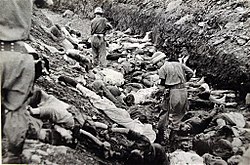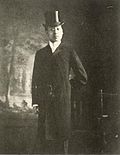Syngman Rhee
Syngman Rhee or Lee Seungman (Korean: 이승만, March 26, 1875 – July 19, 1965) was a Korean independence activist and politician. He was the first president of South Korea. His presidency, from August 1948 to April 1960, remains controversial, affected by Cold War tensions on the Korean peninsula and elsewhere. Rhee was a strong anti-Communist, and led South Korea through the Korean War. His presidency ended in resignation following popular protests against a disputed election. He died in exile in Hawaii.
Syngman Rhee | |
|---|---|
이승만 李承晩 | |
 Official portrait, 1948 | |
| 1st President of South Korea | |
| In office 24 July 1948 – 26 April 1960 | |
| Prime Minister | Lee Beom-seok Shin Sung-mo Chang Myon Yi Yun-yong Chang Taek-sang Baek Du-jin Byeon Yeong-tae |
| Vice President | Yi Si-yeong Kim Seong-su Ham Tae-young Chang Myon |
| Preceded by | Office established |
| Succeeded by | Yun Posun |
| Speaker of the National Assembly | |
| In office 31 May 1948 – 24 July 1948 | |
| Preceded by | Office established |
| Succeeded by | Shin Ik-hee |
| Chairman of the State Council of the Provisional Government of the Republic of Korea | |
| In office 3 March 1947 – 15 August 1948 | |
| Deputy | Kim Gu |
| Preceded by | Kim Gu |
| Succeeded by | Office abolished |
| President of the Provisional Government of the Republic of Korea | |
| In office 11 September 1919 – 23 March 1925 | |
| Prime Minister | Yi Donghwi Yi Dongnyeong Sin Gyu-sik No Baek-rin Park Eunsik |
| Preceded by | Office established |
| Succeeded by | Park Eunsik |
| Personal details | |
| Born | Rhee Syngman 26 March 1875 Neungnae-dong, Daegyeong-ri, Masan-myeon, Pyeongsan County, Hwanghae, Joseon (now North Hwanghae, North Korea) |
| Died | 19 July 1965 (aged 90) Honolulu, Hawaii, U.S. |
| Resting place | Seoul National Cemetery, Seoul, South Korea |
| Nationality | Korean (1875–1910) Stateless (1910–1945) South Korean (1945–1965) |
| Political party | Liberal |
| Spouse(s) | Seungseon Park
(m. 1890–1910) |
| Alma mater | George Washington University (B.A.) Harvard University (M.A.) Princeton University (PhD) |
| Religion | Christianity |
| Signature |  |
| Korean name | |
| Hangul | 이승만 / 리승만 |
| Hanja | 李承晩 |
| Revised Romanization | I Seung(-)man / Ri Seung(-)man |
| McCune–Reischauer | Yi Sŭngman / Ri Sŭngman |
- In this Korean name, the family name is Rhee.
Early life
Rhee was born in Hwanghae Province to Rhee Kyong-sun, a member of the aristocratic Yangban family.[1] Rhee was descended from Prince Hyo-nyong, the second son of King Taejong of Joseon.[1] He soon became active in Korea's struggle against Japanese control. He was arrested in 1897 for demonstrating against the monarchy.
After he was released in 1904 he went to the United States. He obtained several degrees, including a Ph.D. from Princeton University. He began writing his name in the Western manner, with the personal name before the family name. When President Theodore Roosevelt was helping negotiations for the Treaty of Portsmouth, Rhee asked him to put freedom for Korea in the treaty. This did not happen. In 1910, he went back to Korea under Japanese rule. His political actions got him into trouble with the Japanese army, so he left for China in 1912. In 1919, all of the major pro-independence groups formed the provisional Government of the Republic of Korea in Shanghai. Rhee was elected the president, a post he held until 1925 when he was removed by the Provisional Assembly for the misuse of his authority.
Presidency
President of South Korea
At the end of World War 2, Rhee returned to Seoul. This was before the other independence leaders, since he was the only one well known to the Allies. In 1945, he was chosen as head of a provisional (short term) government. With the unspoken agreement of the occupation authorities, Rhee conducted a number of actions to "remove Communism". This was actually a hidden plan to remove all possible opposition to him.
Rhee was elected the first president of South Korea on 10 May, 1948 by a parliamentary vote. He defeated Kim Koo, the last president of the Provisional Government by 180 votes to 16. All the left-wing parties refused to take part in the election. On 15 August 1948, he formally took over from the US military and became the legal power over the Korean people.
As president, Rhee took on dictatorial powers even before the Korean War started in 1950. He allowed the internal security force (headed by his right-hand man, Kim Chang-ryong) to put people in prison and torture them if they were thought to be Communists or North Korean agents. June 1949, Kim Koo was assassinated by Ahn Doo-hee, who siad he did it by the order of Kim Chang-ryong. His government also directed several massacres, the most famous being on the island of Jeju. This was after an uprising by left-wing groups.
Korean war
Rhee made himself unpopular by telling the people in Seoul to stay in the city when the Korean War started. He had already left. His decision to cut the bridges on the Han River stopped thousands of people from escaping from the Communists. The UN and South Korean forces fought back and drove the North Koreans north towards the Yalu River. After a Chinese counterattack the UN and South Korean were pushed back to the current Demilitarized zone. Rhee became unpopular with the US and the UN for refusing to agree to peace plans that would have left Korea divided. He wanted to become the leader of a united Korea with UN assistance. He tried to stop any peace plan that would not remove the northern government completely. He also argued for stronger military action to be used against China. He was annoyed because the US would not bomb China.
On January 18, 1952, Rhee declared South Korean rule over the waters around the Korean peninsula. This was an idea the same as today's exclusive economic zones. The new border, which Rhee called the "Peace Line", included Tsushima Island and the uninhabited islands named Dokdo. This led to protests from the Japanese government. They claimed that the islands were Japanese territory. Minor clashes followed, but the islands have been under South Korean administration since then.
Throughout his rule, Rhee took extra steps to keep his control over the government. In May 1952 Rhee pushed through constitutional changes which made the presidency a directly elected position. To get this passed by parliament he declared martial law. He jailed the members of parliament he thought would vote against it. Rhee was soon elected by a big majority. He regained control of parliament in the 1954 elections. He pushed through an amendment to exempt himself from the eight-year limit on presidents.
Rhee's chances for reelection during the presidential campaign of 1956 seemed small. People did not think he should be allowed to be president three times. The main opposition candidate Shin Ik-hee drew large crowds during his campaign. Shin's sudden death during the campaign, however, allowed Rhee to win the presidency with ease. The runner-up of that election, Cho Bong-am of the Progressive Party, was later charged with spying and executed in 1959.
Resignation
By 1960, Rhee had already served three terms in office. His next victory was certain after the main opposition candidate, Cho Byeong-ok, died shortly before the March 15 elections. Rhee won with 90% of the vote. The real contest was in the race for vice president. This was held separately under the law of the time. Yi Gi-bung, who Rhee thought should take over after him, was declared the winner of an election that the opposition claimed was rigged. This created anger among groups of the Korean people. A student-led April 19 Movement forced Rhee to resign on April 26.
On April 28, a DC-4 belonging to the CIA operated Civil Air Transport took Rhee out of South Korea. This was to rescue him from the angry crowds. Kim Yong Kap, Rhee's Deputy Minister of Finance, revealed that President Rhee had taken $20 million in government money for himself. Rhee, his Austrian-born wife, Francisca Donner, and adopted son lived in exile in Honolulu, Hawaii. On July 19, 1965, Rhee died of a stroke. His body was returned to Seoul and buried in the National Cemetery on July 27, 1965.
Legacy
Rhee's legacy has been in considerable dispute. In general, conservative circles regard Rhee as the patriarch of the nation, while liberals tend to be critical of him.
Rhee's former residence in Seoul, Ihwajang, is currently used for the presidential memorial museum, and Woo-Nam Presidential Preservation Foundation has been set up to honour his legacy.
Book
- 《Dogripjungsin》(독립정신)
- 《Japan Inside Out》
Rhee in songs and movies
- Rhee is mentioned in Billy Joel's history themed song "We Didn't Start the Fire".
- Rhee is mentioned numerous times in Robert Altman's movie MASH (1970). This is a comedy about a team of American army medical officers during the Korean War.
- When the lights go out in the operating room during surgery and then come back on a short time later one of the doctors says "Syngman Rhee paid the electric bill."
- When Hawkeye (Donald Sutherland) takes the young Korean mess hall boy, and his friend, Ho-Jon, to get medical treatment, he tells the South Korean guards that "This is Syngman Rhee's son, he goes right in", so he does not have to wait.
Syngman Rhee Media
Rhee's Library of Congress print, 1939
Rhee and American general Douglas MacArthur at the ceremony inaugurating the government of South Korea
Ceremony inaugurating the government of the Republic of Korea (15 August 1948) at the Governor-General Building in Seoul.
Rhee with President of the Republic of China Chiang Kai-shek in 1949
Rhee depicted on a 1959-issued 100 hwan coin
Rhee in 1905 dressed to meet Theodore Roosevelt
Rhee and Vice President of the Korean Provisional Government Kim Kyu-sik in 1919
Related pages
References
Other websites
![]() Works related to Author:Syngman Rhee at Wikisource
Works related to Author:Syngman Rhee at Wikisource
![]() Media related to Syngman Rhee at Wikimedia Commons
Media related to Syngman Rhee at Wikimedia Commons
- Syngman Rhee Archived 2008-05-17 at the Wayback Machine
- Syngman Rhee's FBI files hosted at the Internet Archive
| Preceded by 'Establishment of the Republic' (Emperor Sunjong) |
Presidents of Provisional Government of South Korea 1919-1925 |
Succeeded by Park Eunsik |
| Preceded by Kim Kyu Sik |
Chairmen of the Interim Legislative Assembly 1948 |
Succeeded by Dissolved (Speaker of the Constituent Assembly) |
| Preceded by 'New Creation' (Chairmen of the Interim Legislative Assembly) |
Speaker of the National Constituent Assembly 1948 |
Succeeded by Shin Ik-hee |
| Preceded by 'Kim Gu' (President of the Provisional Government) Syngman Rhee (Speaker of the Constituent Assembly) |
President of South Korea 1948-1960 |
Succeeded by Heo Jeong (Acting) |










